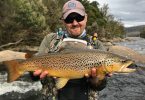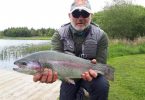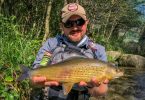When out for a day on the Loughs, I am often surprised by the number of anglers that insist on fishing flies of size 8 or larger. These are usually bushy Bumbles, Dabblers, or winged wets, often heavily dressed. There are times when these flies work, other times they work very well, but if conditions don’t suit they will lead to a blank. Very few Lough anglers pay attention to what they learn on the rivers. If you are fishing to a rising fish on a river and it ignores your fly, but you know that a particular fly is on the water, you will change size; usually a smaller or more lightly dressed fly will do the trick if the presentation is right. Most boat anglers miss this; if a certain pattern doesn’t do the trick, try another instead… regardless of what the trout are likely to be feeding on, or what the natural’s size actually is.
Often my first change will be size or style of fly if there is evidence of naturals on the water. When Conditions are hard, with sun and little wind to create a wave, (which often distorts the trout’s view of your fly) I often set up a “River cast” i.e. Two small spider patterns, and either a hare’s ear or pheasant tail nymph on the point. These flies will be fished slowly on either a floating line, (in a ripple) or an intermediate line if the water is flat. These spider patterns I tie myself as most bought ‘spiders’ are too bushy, mine have one or one and a half turns of hackle only. The sizes vary from 12 to 16, although 14’s are my first preference. These spiders are tied on either standard wet fly hooks or on the heavy ‘grubber’ hooks, by using the grubber hooks with the different profile I know which are the heavier flies in the box, whereas weighting a standard wet fly hook makes the selection of the heavy flies difficult. The heavier flies help sink the cast deeper when the boat is drifting that bit faster. I fish both types of flies with a very slow retrieve, the equivalent of a slow figure of eight, adjusted to the speed of the boat usually works best, a word of warning, chucking them out and stripping them back wont! Some anglers seem to assume trout have an engine up their *rse and strip the flies back at a rate of knots, this can work with the larger lure type flies but for trout selectively feeding it won’t.
I often notice anglers, who fish from the shore on our smaller lakes etc. will fish static or semi-static flies to obviously feeding fish but seem to insist on stripping them back when in a boat, get bored with no action and cast out a couple of dries fished static????? Any angler who has fished from a bank will tell you he often catches fish “on the drop” and the English anglers are adept at fishing wet buzzer patterns static below a ‘bung’ or dry fly. I recall a day on Lough Owel, when my partner and I were out in blazing sunshine chasing herring-bone ripples around the lake, we eventually got tired of the game and decided to stick it out along the Italians shore, we were only waiting for the peter fishing later that evening when the sun had left the water. My boat partner cast two small dries out to his right and sat back to take refreshment. I cast my spiders on a long line to my left on the slime line counted ten and was about to take the first handful of line for my figure of 8 retrieve when the fly line zipped out and I was in. My partner netted both his and my fish, you guessed it, his klinkhamer disappeared very quickly after.
I then spent an hour retrieving the flies very slowly with out any success and saw two more to the dry flies the other end of the boat. That started me thinking, and I switched to a floating line but resisted the urge to put a couple of dries on, and, instead tied on a small hares ear on the point, a size 14 corixa on the middle dropper and an apple green spider on the top, all spaced about four feet apart on a twenty foot cast. This was cast out and left static, the line just being collected enough to keep me in touch with the flies. I worked out that it took about half an hour for the flies to catch bottom, no it wasn’t deep, half an hour and four fish later!
Sadly the method doesn’t always work, and there needs to be feeding fish in the area, but it can be very successful at times. It does pay however to remember the things we learnt on the rivers, and pity those that only ever fished the loughs, they have a lot to catch up!








